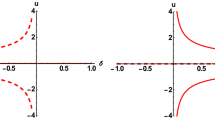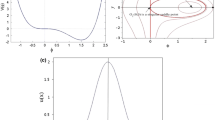Abstract
This paper deals with problems for which it is necessary to represent the oscillations of the electromechanical seismograph about their position of equilibrium as regards the synchronous condition. The loss of stability of the system occurs through a saddle-node bifurcation, where there is a collision of the stable orbit with an unstable one. Then, global bifurcations and chaotic dynamics of an electromechanical seismograph are the aims of this study. The electrical part of the model is described by an extended force Rayleigh oscillator with Φ 6-potential, while the mechanical part is described by a damped and driven linear oscillator. By using the direct perturbation technique, we analytically obtain the general solution of the first-order equation. Through the boundedness condition of the general solution we get the famous Melnikov function predicting the onset of chaos in the case where the Φ 6-potential is three wells, which are complemented by numerical simulations by which we illustrate the bifurcation curves and the fractality of the basins of attraction. The results show that the threshold amplitude of harmonic excitation for the onset of instability will move upwards as the amplitude intensity of the ground motion increases. These results suggest that much attention should be paid to controlling the increase of the amplitude of the ground motion, especially when the harmonic excited electromechanical seismograph system as a main device is applied to some practical systems.
Similar content being viewed by others
References
Rand, R.H., Holmes, P.J.: Bifurcation of periodic motions in two weakly coupled van der pol oscillators. Int. J. Non-Linear Mech. 15, 387–399 (1980)
Arafat, H.N., Nayfeh, A.H.: Non-linear responses of suspended cables to primary resonance excitation. J. Sound Vib. 266, 325–354 (2003)
Ott, E., Grebogi, C., Yorke, J.A.: Controlling chaos. Phys. Rev. Lett. 64, 1196–1199 (1990)
Shinbrot, T., Ott, E., Grebogi, C., Yorke, J.A.: Using small perturbations to control chaos. Nature 363, 411–417 (1993)
Shinbrot, T., Ott, E., Grebogi, C., Yorke, J.A.: Using chaos to direct trajectories. Phys. Rev. Lett. 65, 3215–3218 (1990)
Lima, R., Pettini, M.: Suppression of chaos by resonant parametric perturbations. Phys. Rev. A 41, 726–733 (1990)
Ramesh, M., Narayanan, S.: Chaos control by non-feedback methods in the presence of noise. Chaos Solitons Fractals 10, 1473–1489 (1990)
Braiman, Y., Goldhirsch, I.: Taming chaotic dynamics with weak periodic perturbations. Phys. Rev. Lett. 20, 2545–2548 (1991)
Show, W., Wiggins, S.: Chaotic dynamics of a whirling pendulum. Physica D 31, 190–211 (1988)
Melnikov, V.K.: On the stability of the centre for time-periodic perturbations. Trans. Mosc. Math. Soc. 12, 1–57 (1963)
Holmes, P.J., Marsden, J.E.: Horseshoe and Arnold diffusion for Hamiltonian system on Lie groups. Indiana Univ. Math. J. 32, 273–309 (1983)
Holmes, P.J., Marsden, J.E.: Horseshoes in perturbations of Hamiltonian systems with two degrees of freedom. Commun. Math. Phys. 82, 523–544 (1982)
Holmes, P.J., Marsden, J.E.: Melnikov’s method and Arnold diffusion for perturbations of integrable Hamiltonian systems. J. Math. Phys. 23, 669–675 (1982)
Hegazy, U.H.: Dynamics and control of self-sustained electromechanical seismographs with time varying stiffness. Mecanica 44, 355–368 (2009)
Chedjou, J.C., Kyamakya, K., Moussa, I., Kuchenbecker, H.-P., Mathis, W.: Behavior of a self-sustained electromechanical transducer and routes to chaos. J. Vib. Acoust. 128, 1–12 (2006)
Siewe Siewe, M., Moukam Kakmeni, F.M., Bowong, S., Tchawoua, C.: Non-linear response of a self-sustained electromechanical seismographs to fifth resonance excitations and chaos control. Chaos Solitons Fractals 29, 431–445 (2006)
Moukam Kakmeni, F.M., Bowong, S., Tchawoua, C., Kaptouom, E.: Dynamics and chaos control in nonlinear electrostatic transducers. Chaos Solitons Fractals 21, 1093–1108 (2004)
Yamapi, R., Chabi Orou, J.B., Woafo, P.: Harmonic oscillations, stability and chaos control in a non-linear electromechanical system. J. Sound Vib. 259, 1253–1264 (2003)
Moukam Kakmeni, F.M., Bowong, S., Tchawoua, C., Kaptouom, E.: Resonance, bifurcation and chaos control in electrostatic transducers with two external periodic forces. Physica A 333, 87–105 (2004)
Kitio Kwuimy, C.A., Woafo, P.: Dynamics of a self-sustained electromechanical system with flexible arm and cubic coupling. Commun. Nonlinear Sci. Numer. Simul. 12, 1504–1517 (2007)
Kitio Kwuimy, C.A., Woafo, P.: Dynamics, chaos and synchronization of self-sustained electromechanical systems with clamped-free flexible arm. Nonlinear Dyn. 53, 201–213 (2008)
Ge, Z.-M., Lin, T.-N.: Chaos, chaos control and synchronization of electro-mechanical gyrostat system. J. Sound Vib. 259, 585–603 (2003)
Yamgoué, S.B., Kofané, T.C.: Dynamics of driven coupled oscillators with shape deformable potential. Chaos Solitons Fractals 15, 119–129 (2003)
Siewe Siewe, M., Moukam Kakmeni, F.M., Tchawoua, C.: Resonance oscillations and homoclinic bifurcation in a Φ6-Van der Pol oscillators. Chaos Solitons Fractals 21, 841–853 (2004)
Siewe Siewe, M., Moukam Kakmeni, F.M., Tchawoua, C., Woafo, P.: Bifurcations and chaos in periodically and externally driven Φ6-Van der Pol oscillators. Physica A 357, 383–396 (2005)
Tchoukuegno, R., Woafo, P.: Dynamics and active control of motion of a particle in a Φ6 potential with a parametric forcing. Physica D 167, 86–100 (2002)
Moon, F.C., Li, G.X.: Fractal basin boundaries and homoclinic orbits for periodic motions in a two-well potential. Phys. Rev. Lett. 55, 1439–1442 (1985)
Wolf, A., Swift, J.B., Swinney, H.L., Vastano, J.A.: Determining Lyapunov exponents from a time series. Physica D 16, 285–317 (1985)
Author information
Authors and Affiliations
Corresponding author
Rights and permissions
About this article
Cite this article
Siewe Siewe, M., Yamgoué, S.B., Moukam Kakmeni, F.M. et al. Chaos controlling self-sustained electromechanical seismograph system based on the Melnikov theory. Nonlinear Dyn 62, 379–389 (2010). https://doi.org/10.1007/s11071-010-9725-3
Received:
Accepted:
Published:
Issue Date:
DOI: https://doi.org/10.1007/s11071-010-9725-3




